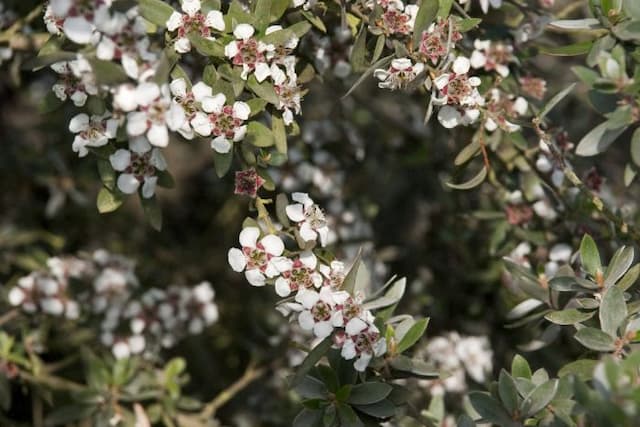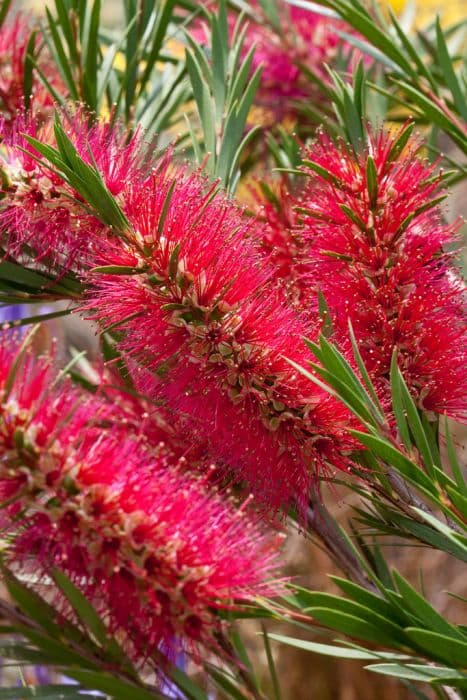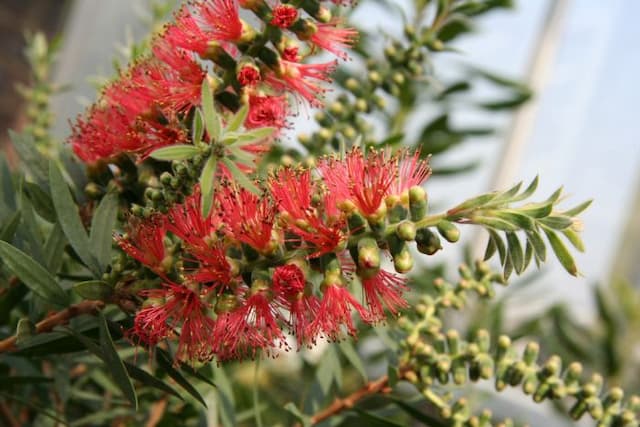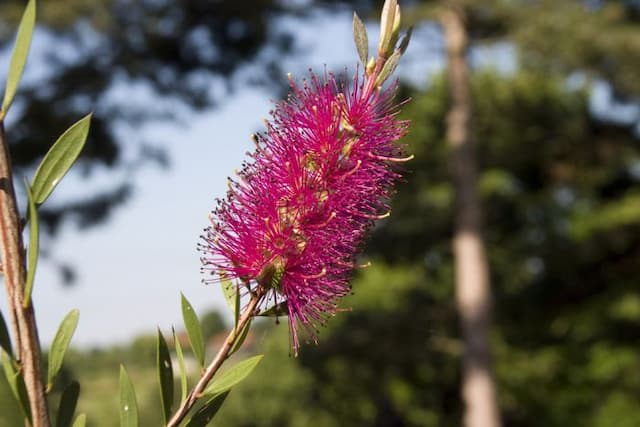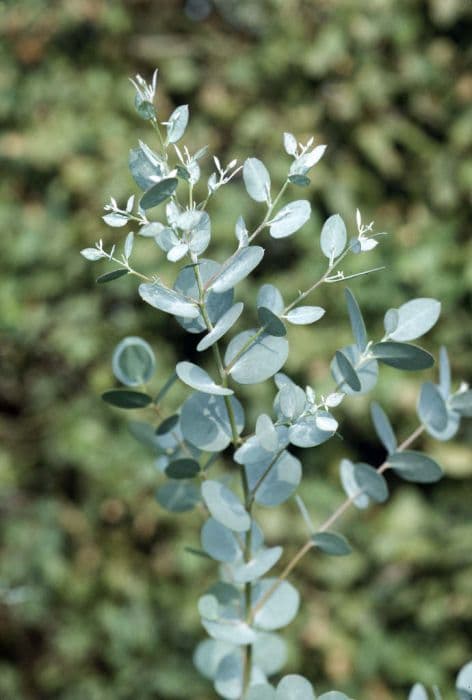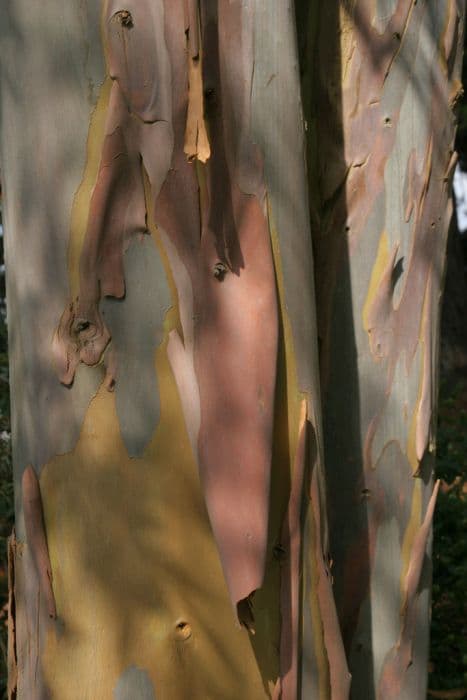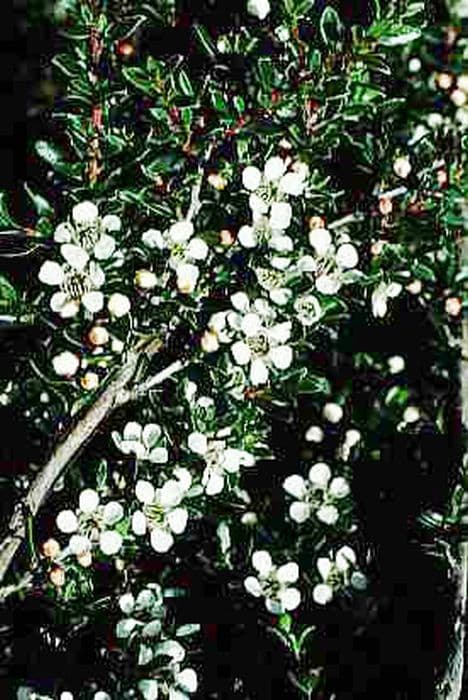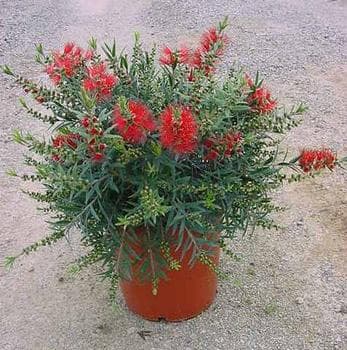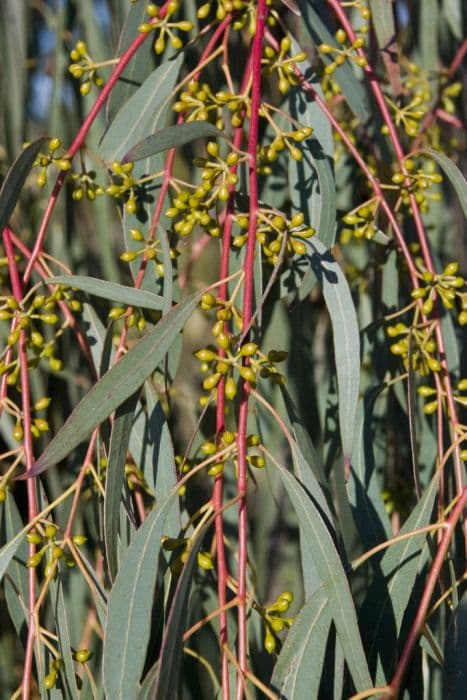Crimson Bottlebrush Callistemon citrinus 'Splendens'
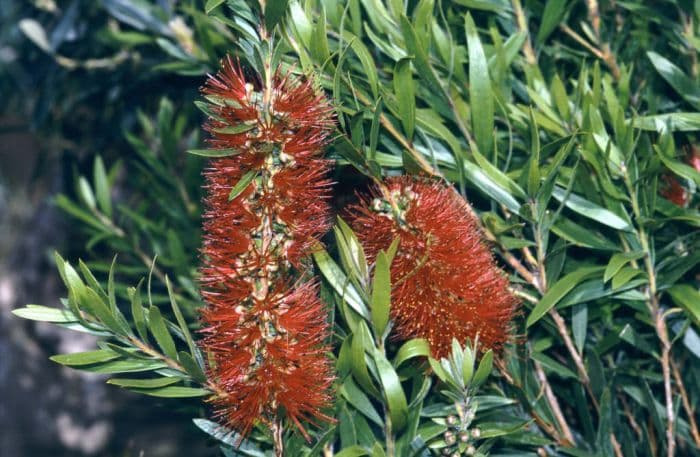
ABOUT
Callistemon citrinus 'Splendens', commonly known as the red bottlebrush, is a striking plant known for its vibrant and showy flowers. It features a profusion of bright red, brush-like flower spikes that are made up of multiple individual flowers with long, protruding stamens, giving it a fuzzy appearance. This provides a stark contrast to the dark green foliage. The leaves of the red bottlebrush are lance-shaped and can release a lemony scent when crushed, adding a sensory experience to its aesthetic appeal. The brightness of the bloom, along with its distinctive shape, attracts various pollinators, including birds and bees. The flowers typically appear in spring and summer, creating a spectacular display. When not in bloom, the plant maintains interest with its evergreen leaves that remain year-round, offering consistent foliage. The appearance of the red bottlebrush, with its unique and dramatic flowers, makes it popular for ornamental garden use, particularly in areas where a visual impact is desired.
About this plant
 Names
NamesFamily
Myrtaceae.
Synonyms
Crimson Bottlebrush, Lemon Bottlebrush, Red Bottlebrush, Splendid Bottlebrush.
Common names
Callistemon lanceolatus DC., Melaleuca citrina (Curtis) Dum.Cours., Metrosideros citrina Curtis, Callistemon splendens.
 Toxicity
ToxicityTo humans
The plant commonly known as Bottlebrush is not typically considered toxic to humans. However, as with any plant, individual allergies or sensitivities could cause reactions in some people. There is no widespread evidence of poisoning by ingestion of Bottlebrush, and it is generally regarded as safe around humans.
To pets
Bottlebrush is generally considered non-toxic to pets such as dogs and cats. There are no specific symptoms associated with Bottlebrush poisoning in pets, as it is not known to cause harmful effects if they ingest parts of the plant. Just like with humans, pets may have individual allergies, so it is always a good practice to monitor for any negative reactions if they come into contact with the plant.
 Characteristics
CharacteristicsLife cycle
Perennials
Foliage type
Evergreen
Color of leaves
Green
Flower color
Red
Height
6 feet (1.83 meters)
Spread
5 feet (1.52 meters)
Plant type
Shrub
Hardiness zones
9
Native area
Australia
Benefits
 General Benefits
General Benefits- Attracts Pollinators: The showy red flowers of the bottlebrush are rich in nectar, drawing in bees, birds, and butterflies, which help pollinate the plant and other plants in the vicinity.
- Easy Maintenance: This plant is known for being low-maintenance, requiring minimal care once established, making it a good choice for gardeners of all skill levels.
- Drought Tolerance: Once established, the bottlebrush has a good tolerance to drought, making it suitable for landscapes in arid climates and reducing the need for frequent watering.
- Erosion Control: The bottlebrush's root system can help stabilize soil and prevent erosion, particularly on slopes or in areas prone to heavy rains.
- Aesthetic Appeal: With its brilliant crimson-red flowers, the bottlebrush provides a vibrant splash of color to any garden setting, enhancing the overall landscape design.
- Habitat Provision: It offers shelter and nesting sites for various species of birds, contributing to the local ecosystem's health and biodiversity.
- Privacy and Screening: When planted in groups or rows, bottlebrushes can serve as an effective natural screen or privacy hedge, blocking unwanted views or noises.
- Coastal Tolerance: Bottlebrush is well-suited for coastal areas as it can tolerate salty winds and sprays, making it ideal for seaside gardens.
- Versatile Landscaping: It can be used in a variety of landscaping applications, such as specimen planting, borders, containers, and even as a topiary subject due to its adaptable growth habit.
 Medical Properties
Medical Properties- Antimicrobial: Callistemon citrinus 'Splendens', commonly known as Crimson Bottlebrush, has been found to possess antimicrobial properties against certain strains of bacteria and fungi.
- Anti-inflammatory: Some studies suggest that extracts from the Crimson Bottlebrush may have anti-inflammatory effects, which could be beneficial for reducing inflammation in the body.
- Antioxidant: The plant may contain compounds with antioxidant properties, which can protect the body from oxidative stress and free radicals.
 Air-purifying Qualities
Air-purifying QualitiesThis plant is not specifically known for air purifying qualities.
 Other Uses
Other Uses- Bottlebrush plants like Callistemon citrinus 'Splendens' can be used in floral arrangements for their bright, unique flowers that add texture and a splash of color.
- They are often planted as a natural fence or privacy screen due to their dense foliage.
- The fibrous wood of the Bottlebrush can be used in the production of small wooden items, such as handles for tools.
- Their nectar-rich flowers are excellent for attracting and nourishing bees, which can benefit the pollination of nearby gardens and crops.
- Bottlebrush can be used in companion planting to protect other plants, as their strong scent may deter certain pests.
- These plants can be cultivated as bonsai, adding an exotic touch to the traditional Japanese art form.
- In large-scale landscaping projects, the striking Bottlebrush is used for erosion control, thanks to its robust root system stabilizing the soil.
- Callistemon citrinus 'Splendens' can be used as an educational tool for students learning about botany, specifically regarding plant adaptations to attract pollinators.
- They are sometimes used to add a burst of color to urban environments, including traffic roundabouts and roadside plantings, which can cheer up an otherwise drab setting.
- Bottlebrush can be planted in areas where runoff water needs to be absorbed, thereby mitigating water pollution in sensitive ecosystems.
Interesting Facts
 Feng Shui
Feng ShuiThe Bottlebrush is not used in Feng Shui practice.
 Zodiac Sign Compitability
Zodiac Sign CompitabilityThe Bottlebrush is not used in astrology practice.
 Plant Symbolism
Plant Symbolism- Resilience: Bottlebrush (Callistemon citrinus 'Splendens') is a hardy plant that can tolerate a variety of growing conditions, symbolizing the ability to endure and thrive through challenges.
- Purity: The bottlebrush's vibrant red flowers resemble a traditional brush for cleaning bottles, suggesting a symbolic cleansing action or purity of thought and deed.
- Rejuvenation: As the bottlebrush blooms with bright and abundant flowers, it signifies rebirth and a fresh start.
- Attraction: The striking flowers of the bottlebrush are known to attract birds, especially hummingbirds, symbolizing allure, and the ability to draw others towards oneself.
- Protection: In some cultures, the bottlebrush is believed to have protective properties, offering a shield against negative forces.
 Water
WaterThe Bottlebrush (Callistemon citrinus 'Splendens') prefers consistent moisture, especially during its growing season in spring and summer. Water the plant deeply until the soil is saturated but not soggy, which typically means applying about 1 to 1.5 gallons for an average-sized shrub every week, depending on the climate and soil drainage. During the hotter months, you may need to water twice a week. In winter, reduce watering to every other week or less, as the plant is dormant and requires less moisture. Always check the top inch of soil for dryness before watering to prevent overwatering, which can lead to root rot.
 Light
LightThe Bottlebrush thrives best in full sun conditions, where it can receive at least six to eight hours of direct sunlight daily. Choose a spot in your garden that is exposed to ample sunlight for the healthiest growth and flowering. While it can tolerate part shade, the Bottlebrush's bloom may not be as prolific, and the plant may become leggy as it reaches for the light.
 Temperature
TemperatureBottlebrush plants prefer warm climates and are hardy in temperatures that do not typically drop below 20⁰F. They can survive short periods of colder temperatures but may be damaged if prolonged freezing occurs. The ideal temperature range for Bottlebrush plants is between 50⁰F and 90⁰F. They thrive in USDA hardiness zones 8 through 11, where temperature extremes are rare.
 Pruning
PruningPrune the Bottlebrush after it finishes flowering to maintain its shape and encourage bushier growth. Light pruning can be done any time of year to remove dead or damaged branches. Intensive pruning should be done in late winter or early spring before the new growth starts. Pruning is also necessary to remove any spent flowers, which promotes a second bloom and keeps the shrub tidy.
 Cleaning
CleaningAs needed
 Soil
SoilThe Bottlebrush (common name for Callistemon citrinus 'Splendens') prefers well-draining, sandy to loamy soil with a slightly acidic to neutral pH of 5.5 to 7.0. A mix containing peat, perlite, and compost is ideal to provide the drainage and nutrients necessary for optimal growth.
 Repotting
RepottingBottlebrush plants should typically be repotted every 2-3 years or when they outgrow their pots. It's best to repot in spring just before the growing season begins.
 Humidity & Misting
Humidity & MistingBottlebrush plants thrive in a moderate humidity environment, generally around 40-50%, which is often the typical indoor humidity range, making special humidity adjustments unnecessary.
 Suitable locations
Suitable locationsIndoor
Place in bright, indirect light and ensure good air circulation for indoor Bottlebrush.
Outdoor
Plant in a sunny spot with well-draining soil for outdoor Bottlebrush growth.
Hardiness zone
8-11 USDA
 Life cycle
Life cycleCallistemon citrinus 'Splendens', commonly known as Crimson Bottlebrush, begins its life cycle with the germination of its small seeds typically after a fire or in warm, moist soil conditions. Following germination, the seedlings gradually establish a root system and grow into juvenile plants exhibiting linear leaves. As it matures into an adult, the Crimson Bottlebrush develops woody stems and bright red, brush-like flowers rich in nectar, attracting pollinators such as birds and insects. After pollination, the flowers form woody capsules which contain the seeds; these capsules can remain on the plant for many years before releasing the seeds. The adult Crimson Bottlebrush reaches its full size, continues to flower annually, and can live for many years, exhibiting a woody growth habit. At the end of its life cycle, the plant eventually declines and dies, releasing its seeds to start the cycle anew if the conditions allow.
 Propogation
PropogationPropogation time
Spring-Early Summer
Callistemon citrinus 'Splendens', commonly known as the Crimson Bottlebrush, is most commonly propagated using semi-hardwood cuttings. The best time to propagate this plant through cuttings is in late summer to early autumn. To do this, a cutting of about 4 to 6 inches (10 to 15 centimeters) in length is taken from a healthy, disease-free branch. The lower leaves are removed, and the cut end can be dipped in rooting hormone to encourage root development. The cutting is then placed in well-draining soil or a potting mix and kept moist until roots have developed, which usually takes several weeks. During this rooting period, the cutting should be kept in indirect sunlight and in a warm environment to facilitate growth.
